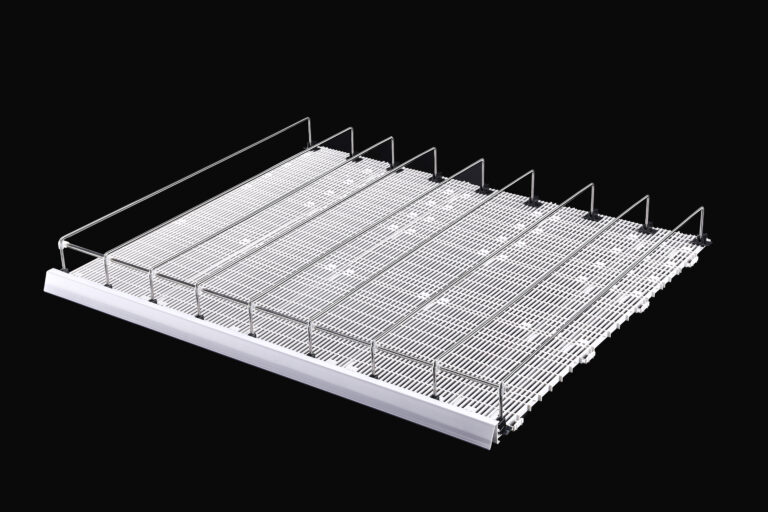Keeping shelves neat in a freezer aisle is a challenge. Ice, moisture, and cold can wreck most plastic fixtures. Yet stores need tidy displays and fast restocking—even at –10 °C. How can one simple mat handle that?
Our gravity shelf sliding mats use HDPE bases and GPPS dividers to resist frost, stay flexible, and keep products gliding forward—even in deep cold. No cracking, no sticking, just smooth operation.
Ready to see why freezer aisles are the perfect place for these mats? Let’s dive into the cold.
What makes sliding mats work at –10 °C?
Imagine a mat that slides bottles forward by itself in a freezer. No power. No springs. Just gravity and smart materials. At –10 °C, plastics can become brittle. But our mats stay flexible and strong.
The role of low-friction surfaces
A sliding mat needs a smooth surface so items move easily. We mold each HDPE base with a low-friction finish. That prevents cans or boxes from catching on frost.
How gravity and angle combine
A 6°–9° incline pushes items forward gently. At –10 °C, that angle must overcome any tiny ice crystals. Our surface minimizes ice adhesion. Combine that with just enough slope, and products glide every time.
Material synergy in cold
HDPE stays tough at low degrees. GPPS dividers keep their shape and snap into place without cracking. Together, they form a mat that works under harsh cold.
| Property | HDPE Base | GPPS Divider |
|---|---|---|
| Cold flexibility | Excellent | Good |
| Impact resistance | High | Medium |
| Surface smoothness | Very low friction | Clear, rigid |
When most plastics fail, this combo shines—keeping your freezer aisles both neat and efficient.
How does HDPE perform in cold storage?
HDPE (High-Density Polyethylene) is known for toughness and safety. It’s food-grade, moisture-resistant, and flexible even below freezing.
Why HDPE resists cracking
Some plastics shrink or crack in cold. HDPE’s molecular structure lets it bend without breaking. That means mats last longer, even with heavy loads and temperature swings.
Moisture and mold defense
Freezers build up condensation. HDPE resists water absorption. That stops mold growth and keeps mats easy to clean. No more frozen clumps on the shelf surface.
Cleaning and sanitation in cold
A quick wipedown is all you need. HDPE’s non-porous finish prevents residues. Even at –10 °C, mats stay smooth. That saves staff time and cuts downtime between restocks.
| Test Condition | HDPE Result |
|---|---|
| Freeze/thaw cycles | No cracking |
| Moisture exposure | No swelling |
| Load stress at –10 °C | Maintains shape |
With HDPE, freezer shelves stay functional and safe for food items.
Why use GPPS dividers in cold mats?
Dividers are crucial to keep bottles from colliding or tipping. In cold, many plastics get brittle. GPPS (General Purpose Polystyrene) holds up with clarity and moderate cold strength.
Stability in low temperatures
GPPS stays rigid enough to guide products. At –10 °C it won’t snap under pressure. It keeps lanes separate and organized.
Clear visibility
Transparent dividers let customers see labels. GPPS clarity remains even in frost. That means better merchandising and fewer gaps.
Easy repositioning
Staff can move GPPS dividers without special tools. They snap in and out, even with cold gloves on. That flexibility suits changing product sizes.
| Feature | Benefit in Cold Use |
|---|---|
| Rigidity | Prevents divider bending |
| Clarity | Maintains label visibility |
| Snap-fit design | Quick adjustments |
GPPS brings structure and visibility to deep-cold displays without compromise.
Can sliding mats resist frost buildup?
Ice can stop most mats from working. Our design fights frost with material choice and surface texture.
Smooth, non-porous HDPE base
HDPE prevents water from seeping in. Condensation beads up and slides off, not into the mat.
Slight surface pattern
A minimal groove pattern channels moisture away from contact points. Products still glide, but frost has fewer places to stick.
Warm-air crossover
Freezer doors open often. Our mats help airflow under items, reducing ice in display zones. That keeps both product and shelf clear.
| Frost Factor | Mat Solution |
|---|---|
| Surface ice | Channels via micro-grooves |
| Trapped moisture | HDPE non-porous resistance |
| Rapid temperature change | Stable plastic structure |
With these features, frost buildup is no match for our sliding mats.
How do mats prevent product sticking?
Cold surfaces often cause cans or bottles to freeze in place. That stops sliding and frustrates customers.
Low-adhesion coating
We add a food-safe finish to the HDPE that reduces adhesion. Even light frost can’t glue items to the mat.
Divider buffering
GPPS dividers keep products from rubbing the side walls, which can cause sticking. They maintain a uniform gap for easy movement.
Regular airflow design
Our mats are slightly raised off the shelf base. This allows air to flow beneath, drying surfaces quickly and helping products stay loose.
| Sticking Cause | Prevention Method |
|---|---|
| Surface frost | Low-adhesion HDPE finish |
| Sidewall contact | GPPS divider buffering |
| Moisture buildup | Under-mat airflow channels |
These measures ensure items move, not stick.
What shelf angle suits –10 °C use?
A precise incline is key. Too steep, products topple. Too flat, they won’t move.
Finding the sweet spot
We recommend 6°–9° for deep-freeze shelves. That range balances gentle push with safe stability.
Adjusting existing racks
Many freezers let you tweak rack angles. If not, slim spacers under the back edge do the trick. No major retrofit needed.
Custom angle support
Our mats work across small angle variations. Each design accounts for typical freezer rack tolerances, so you get consistent sliding.
| Angle | Movement Behavior |
|---|---|
| 0°–3° | No sliding, static display |
| 4°–6° | Occasional sliding, semi-automatic |
| 6°–9° | Reliable, controlled sliding |
| >9° | Fast slide, risk of tipping |
Stick within 6°–9° and let gravity and design do the work.
How to install mats in freezers?
Complex installs slow projects. Our mats are plug-and-play, even in cold aisles.
Tool-free placement
Just lay the HDPE base on the rack. The mat’s weight and friction keep it in place.
Divider setup
Snap GPPS dividers into the side slots. They click in firmly, even when chilled.
Fine-tuning
Adjust your shelf angle if needed. Make sure the mat sits flush. Load a few test items to confirm smooth sliding.
| Step | Time Estimate |
|---|---|
| Base placement | 30 seconds |
| Divider snapping | 1 minute |
| Angle adjustment | 2–5 minutes |
| Test load | 1 minute |
Front-line aisles can be ready in under 5 minutes each.
Do mats need special fridge cleaning?
Freezer hygiene is strict. Mats must meet food safety rules and stay easy to clean.
Simple wipe-down
HDPE resists stains and moisture. A damp cloth with mild detergent removes spills in seconds.
Divider removal
GPPS dividers pop out for deeper cleaning. Rinse under warm water and let air dry.
Sanitation compliance
Materials meet FDA and EU food-contact standards. They withstand regular cleaning cycles in busy stores.
| Cleaning Task | Frequency | Method |
|---|---|---|
| Surface wipe | Daily | Cloth + mild detergent |
| Divider deep clean | Weekly | Warm water rinse |
| Full shelf check | Monthly | Visual inspection |
No special chemicals or tools required—just standard fridge cleaning routines.
What load can mats handle at –10 °C?
Freezers often hold heavy drink crates or stacked boxes. Mats must support that weight.
Material strength
HDPE bases flex slightly under load but never sag permanently. GPPS dividers add channel support for heavy items.
Load testing results
Each mat holds up to 20 kg per lane without deformation or slowdown in sliding performance.
Distribution of weight
Even if you place a heavy crate at the back, items still glide. The mat’s structure spreads load evenly across its width.
| Test Load | Behavior |
|---|---|
| 5 kg per lane | Smooth sliding |
| 10 kg per lane | Slight flex, no sag |
| 20 kg per lane | Full support, no damage |
| >20 kg per lane | Not recommended |
For most frozen food and beverage displays, this capacity is more than enough.
How long do cold-use mats last?
Durability in cold is key to ROI. Frequent replacements eat into savings.
Longevity factors
HDPE resists wear from sliding bottles. GPPS dividers keep snaps tight. Frost and moisture don’t degrade material.
Real-world lifespan
In typical freezer aisles, mats last 3–5 years before showing wear—often much longer in less-used sections.
Maintenance tips
Avoid sharp tools on the surface. Clean with mild detergent only. Inspect dividers quarterly for tightness.
| Condition | Expected Lifespan |
|---|---|
| High-traffic aisles | 3 years |
| Moderate use aisles | 4 years |
| Low-traffic zones | 5+ years |
Well-maintained mats deliver years of efficient, trouble-free service.
Conclusion
Freezer aisles demand tough, reliable fixtures. Our gravity shelf sliding mats, built from HDPE bases and GPPS dividers, thrive at –10 °C. They resist frost, prevent sticking, and keep products front-facing with minimal effort. Easy to install and clean, they save labor, boost sales, and last for years. Upgrade your cold displays today and see how simple, smart design can transform your restocking in any chilled environment.



